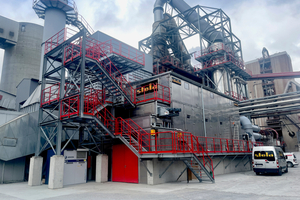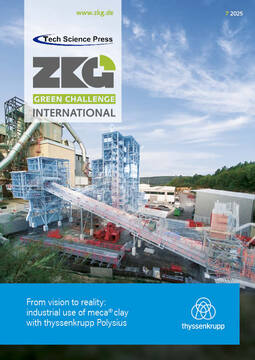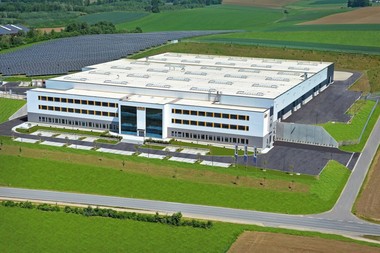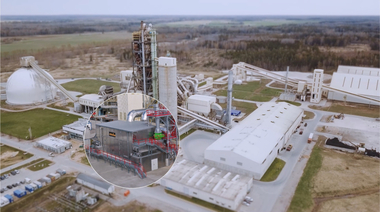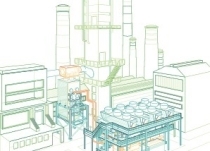Transforming Green Challenge into Innovation: The Allmendingen RDF Drying Project as a model for integrated decarbonisation of an industrial sector
With the project for utilizing waste heat from the clinker cooler exhaust at the Allmendingen site, SCHWENK demonstrates how innovative energy optimization can enable triple use of waste heat. As early as 2009, SCHWENK made significant investments to efficiently harness the waste heat generated during cement production in the rotary kiln. However, one-third of the thermal energy remained unused. With the implementation of this project, the final third of the waste heat will now also be reintegrated into the cycle and used sustainably. This is made possible through the interaction of several plant components, including an ORC (Organic Rankine Cycle) system for in-house electricity generation, a drying facility for fuel derived from commercial and municipal waste, and a plate heat exchanger in the pump house for producing hot water. As a result, more than 8.5 million kWh of energy and over 13200 tons of CO2 can be saved annually. This represents a sustainable contribution to environmental and nature conservation by reducing exhaust air flows and conserving resources through the reduction of primary fuel consumption in the cement industry.
Engineering a solution within spatial constraints
One of the most significant challenges at the Allmendingen site was the limited available space for new equipment. Traditional layouts for drying systems were not feasible due to the plant’s existing infrastructure and spatial configuration. In response, stela implemented a custom-engineered solution that redefined conventional design norms. The exhaust air fans, which are typically positioned adjacent to or above the dryer, were instead installed behind the unit. These fans were connected via specially designed shafts routed beneath the belt system, allowing for efficient airflow management without encroaching on valuable surface area.
By aligning the dryer with the customer’s operational layout, stela ensured that the new system could be incorporated without requiring extensive modifications to the surrounding facilities.
Harnessing waste heat for sustainable fuel preparation
A cornerstone of the project’s innovation lies in its effective utilization of waste heat. The Allmendingen plant, operated by SCHWENK, previously vented approximately one-third of the hot air generated by its clinker cooler directly into the atmosphere. This represented a substantial loss of thermal energy and an inefficiency in the overall process. The new belt dryer system captures this previously wasted heat and repurposes it to dry refuse-derived fuel (RDF) — a material composed primarily of shredded plastics and other combustible waste products.
By using this low-grade waste heat, the plant not only improves its energy efficiency but also significantly reduces its carbon footprint. As Daniel Werkstetter, the project manager responsible for the installation, explains: “By repurposing thermal energy that would have otherwise been lost, the plant achieves meaningful emissions reductions and aligns with broader environmental regulations.” This approach exemplifies how industrial operations can align with sustainability goals without sacrificing productivity or reliability.
Modular design and replicability
The modular nature of the stela belt dryer was another critical factor in the project’s success. Its adaptable design allows for customization to meet the specific needs of different sites, making it a viable solution for other industrial facilities facing similar spatial or operational constraints. This flexibility is particularly valuable in retrofit scenarios, where existing infrastructure often limits the feasibility of conventional equipment installations.
The Allmendingen project demonstrates that modernization of core industrial processes does not necessarily require new construction. Instead, intelligent design and modular engineering can enable existing plants to adopt advanced technologies that enhance both environmental performance and operational resilience.
The integration of RDF drying with clinker cooler waste heat yields a range of cascading benefits. First and foremost, it reduces the plant’s reliance on auxiliary fossil fuels by enabling the use of RDF as a primary energy source. This not only lowers fuel costs but also supports the use of lower-quality, more variable waste-derived fuels, thereby contributing to a circular economy model and minimizing the CO2 Footprint of these Carbon intensive industry.
Consistent drying of RDF to the optimal moisture content is essential for stable combustion in the rotary kiln. Improved combustion stability leads to enhanced kiln performance, reduced emissions, and lower maintenance requirements. These operational improvements translate into tangible economic and environmental gains, reinforcing the value of integrated process design. Moreover, the project illustrates how custom drying installations can serve dual roles as both environmental upgrades and productivity enhancers. The engineering team had to address complex challenges related to airflow dynamics, structural load distribution, and energy flow modelling. Despite the unconventional layout, the system was optimized to maintain high performance, demonstrating the versatility and robustness of belt drying technology.
Production, assembly, and collaborative execution
The belt dryer was manufactured at stela’s production facility in Massing/Germany, where each component was fabricated in accordance with rigorous quality standards. The assembly process at the Allmendingen site was carried out in close collaboration with SCHWENK engineering team, ensuring that local conditions and client-specific requirements were incorporated into every phase of the installation.
Special attention was given to aligning the dryer within the existing spatial constraints and integrating it with the site’s energy and automation systems. Detailed planning during the pre-installation phase ensured that the entire process — from delivery to commissioning — proceeded smoothly and on schedule.
The success of the installation also underscores the importance of cross-functional project management. Engineers, plant operators, and construction teams worked in parallel to address challenges in real time. This collaborative approach not only reduced installation timeframes but also generated valuable insights for future projects in similarly constrained environments.
Strategic impact and future outlook
As one of Germany’s leading cement producers, SCHWENK maintains stringent standards for product quality and operational reliability. The stela drying system at Allmendingen is calibrated to meet these standards with precision, ensuring consistent fuel preparation and kiln performance. With the successful commissioning of the Allmendingen site, all major SCHWENK cement locations — including Bernburg, Karlstadt, Heidenheim-Mergelstetten, and Brocēni in Latvia — now utilize stela belt drying technology. This widespread adoption reflects a company-wide commitment to energy-efficient and environmentally responsible fuel preparation.
The Allmendingen installation is part of a broader energy optimization strategy that includes an Organic Rankine Cycle (ORC) system for electricity generation and a downstream heat recovery unit for hot water production. Together, these systems enable the site to save over 8.5 million kilowatt-hours per year and avoid more than 13200 t of CO₂ emissions annually.
Conclusion: A blueprint for sustainable industrial innovation driven by Green Challenge
The Allmendingen RDF drying project exemplifies how advanced drying technology can serve as a strategic lever for decarbonizing cement production. It highlights the role of low-temperature belt drying systems in enabling plants to operate more sustainably while maintaining or even enhancing process stability. As regulatory pressures and energy costs continue to rise, such integrated solutions will become increasingly central to future-ready industrial design. This case study demonstrates that belt dryers are not merely auxiliary systems but can function as core enablers of next-generation manufacturing strategies — supporting goals related to decarbonization, energy recovery, and circular economy alignment.

